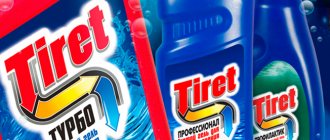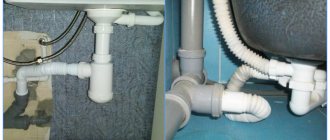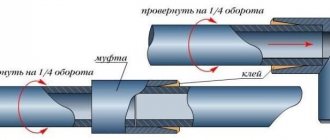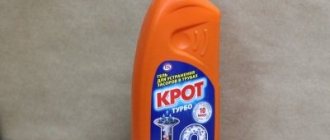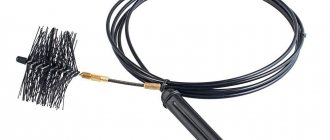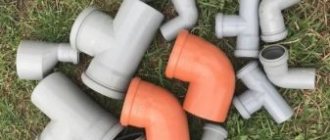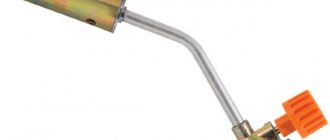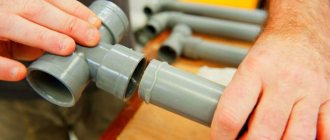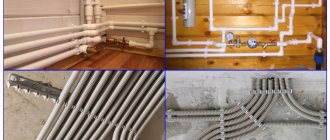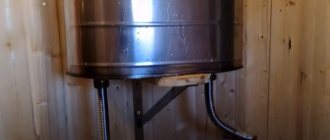When chemical means of eliminating blockages in a siphon or sewer do not work, a rigid plumbing cable for cleaning pipes comes to the rescue - with its help you can eliminate the problem in one go.
To work with the equipment, you do not need to have special qualifications; the main thing is to choose the right cable and follow the simple rules for its use. The article is devoted to solving these questions.
We suggest you figure out which tool is best to use in a given situation, and which attachments are suitable for cleaning sewer pipes. The instructions we offer will help you clear the blockage yourself, without waiting for a plumber to arrive.
Types of blockages and their causes
Before purchasing a cable to remove a sewer plug, it is necessary to determine the cause of the blockage, because in some cases mechanical and chemical means are not enough and the only solution to the problem is to disconnect the pipes.
All blockages are divided into three categories:
- mechanical;
- operational;
- technological.
Mechanical blockages most often occur due to the fault of children who lower large toys or household items into the toilet or bathtub.
They partially block the pipes and trap fibrous structures and hair. Such blockages rarely completely block the flow of water and lead to emergency situations. Eliminating the problem often ends with dismantling the pipes.
Operational blockages periodically form in pipes with a slight slope and a large amount of greasy waste. The inner surface of the pipes slowly becomes overgrown with fat, to which hair, food particles and mechanical impurities stick.
Over time, the throughput of the pipeline decreases, and the sewer requires flushing. It is best to eliminate operational blockages using cables.
Operational blockages require lengthy cleaning of the entire length of the clogged pipe. During their elimination, it is advisable to ensure that the pipe is constantly filled with water so that the garbage is gradually washed into the sewer riser
Technological reasons for pipes becoming clogged with debris are the result of gross errors in the design and installation of sewer systems. Solid particles and fat deposits quickly accumulate in pipes and bends with insufficient slope.
After eliminating such a blockage, it is important to exclude its cause, otherwise in a few weeks you will have to clean the pipes again.
Each blockage has not only its own cause, but also optimal means of elimination. One of the options for cleaning pipes is the proven mechanical method using plumbing cables of various designs.
Image gallery
Photo from
Plumbing cables for breaking through blockages
An alternative method for punching drains and pipes
Preventive measures against blockages
Selection of cable according to pipe diameter
Where are cables used?
The tool was originally invented to clean toilets in American apartments. Over time, the equipment changed slightly and the industry began to produce different types for each pipe.
Where is the sewer cable used:
- in apartments and residential buildings, for cleaning basement sewers;
- on storm and sewer lines;
- for water supply systems.
Each cable is used for pipes of the appropriate diameter and expected contamination.
Types of plumbing cables
Due to the large number of manufacturers of plumbing cables, the options for making their cord and endings are quite varied. All devices are often united only by a handle for scrolling the cable along the axis. Almost all models are equipped with it.
According to their internal structure, cables are divided into the following types:
- cable;
- spring;
- spring-wound.
These cables are used for various blockages and require more detailed consideration.
Type #1: Rope Wire
The rope type of cable is the simplest solution for cleaning apartment drains. It has the form of a cord twisted from spirally twisted galvanized steel wires. Its thickness rarely exceeds 6 mm, and its length is usually 1.5-5 m.
Such a cable can be made independently from a piece of rope by constructing a device on one side that allows rotational movements.
Features of rope rope:
- Withstands high torque in the direction opposite to the curl.
- Wear-resistant and durable.
- Weak penetration force due to small diameter.
- High probability of dissolution at the end.
- Not elastic, but has good passage through pipes and sewer bends due to its small thickness.
This cable is suitable for clearing small operational blockages in apartments. Poorly cleans fibrous and hair plugs.
Type #2: spring-wound cable
The spring-wound cable is not professional and is used on a par with the rope type for domestic purposes.
It represents a spring wire wound around a central void. The thickness varies between 5-10 mm, and the length is 2-5 meters.
The spring cable is cheap and takes up little space. Thanks to its ribbed structure, it cleans pipe walls well along the entire length
Features of the spring-wound cable:
- Withstands strong torque in the direction opposite to the curl.
- Very flexible, prone to forming loops in wide pipes.
- It is impossible to pull without irreversible longitudinal deformations if the end of the cable gets caught.
- Goes well around sewer bends.
- Not equipped with attachments.
- Difficult to maintain: hard-to-reach dirt accumulates in the internal cavity.
The flexibility of the spring does not allow creating a punching force, but the likelihood of damage to sewer joints is significantly reduced.
It is recommended to use a spring-wound cable to clear soft apartment blockages with a large number of bends in the sewer system.
Type #3: spring cable with core
The cable is a steel core made of twisted wire, which is wrapped around the outside with a spring spiral. The shaft diameter can be up to 30 mm, but the standard values are 13.5 mm and 16 mm. The length can reach 60 meters.
The spring cable is used not only for domestic needs, but also for breaking through severe blockages in intra-house risers and even in city sewers.
There are two main modifications of this cable:
- with a core rotating around the shell;
- with a rigidly fixed core.
Rigid-core devices are similar to rope-type cables. They consist of several layers of twisted wire, each of which is wound in the direction opposite to the previous layer. The last layer is wound in the form of a spring
The advantage of a spring cable with a rigid core is the ability to make a “rose” at the end of the rope without the risk of unraveling the overlying wires
The result is a cable that is incredibly strong and resistant to torsion in any direction. At the end there is usually a mount for a nozzle.
The rotation handle is attached directly to the inner shaft, and the cable holding sleeve is fixed to the outer shell
In a cable with a core rotating around the sheath, the last layer is wound with a gap. The end of the core has a mount for a nozzle. The twist handle is attached directly to the core.
This design allows you to push the cable inside the clogged pipe over a long distance and clear the clog with a nozzle only at the exit from the outer shell.
Features of core spring cable:
- withstands strong torque;
- has high penetration ability;
- sewer deposits do not spray out from the cable when twisting;
- not flexible, does not fit into straight bends well;
- does not scratch the entire length of the pipe being cleaned;
- equipped with nozzles.
A spring cable with a rotating internal shaft is often used by professional plumbers, but at home it can also break through a blockage without any problems.
How to make a cable yourself
Instead of a factory device, you can make a cable for cleaning sewer pipes with your own hands. For work, you can use the materials available at hand. The simplest analogue of the tool in question is a piece of flexible wire with a bent end. This device will perfectly cope with shallow blockages, and the flexibility of the thick wire allows it to be used even on curved sections of the drain system.
A regular steel cable can be used as the basis of the flexible shaft. You just need to make a handle and attach it to the cable.
The sequence of actions to answer the problem of how to make a sewer cleaning cable with your own hands looks like this:
- A piece of the length required for work is cut from the metal cable.
- On one side the end fluffs out.
- On the opposite side, the cable is twisted into a ring and a handle is attached for ease of operation..
- The surface is treated with a composition with anti-corrosion properties.
A tool made using the described method can be used to remove any type of problem. This tool is considered universal and suitable for both professional cleaning and for troubleshooting by apartment and house owners.
Additional equipment for cables
In addition to the cable itself, there is additional equipment that facilitates the process of clearing the blockage.
It includes the following devices:
- manual spinner with cable drum;
- electric machine for torsion and winding of cable;
- nozzles;
- flexible shells.
Electrical and mechanical drain cleaning devices make the process of twisting and winding the cable easier. Using a drum allows you not to twist the entire dirty cable located outside and not splash dirt around the bathroom.
Electrical equipment for sewer cleaning is used mainly by professionals due to its high cost and the need for special operating skills.
Nozzles on the end of the cable are used to increase the efficiency of eliminating blockages, depending on the type of debris and the diameter of the pipe being cleaned. And the rubberized coating of spring models makes it easier to pass through pipes and speeds up cleaning the product after work.
Differences between cable types
You can find four types of plumbing cable for drain cleaning in a retail establishment:
- Ropeway . This option visually looks like a thin rod made of a dozen metal wires;
- Spring-loaded . The device resembles a hollow spring made from coils of wire;
- Spring-wound . The tool has a flexible core and a spiral wound on the outside;
- Tape . Metal tape with a width of 1 to 4 centimeters.
Tape and rope rope
Each of the above types of cable is equipped with working elements made of high-strength steel. In some models, the coating of the outer spiral is made rubberized, that is, capable of protecting the internal walls of sewer parts from the mechanical impact of metal.
However, most often in the store you can find the usual steel cable without any braids.
Sewer cable attachments
Each plumbing cable is equipped with a special tip for cleaning pipes from debris. But at the end of a cheap rope rod, you can make a “rose” yourself by first winding a section 5-6 cm from the edge with copper wire so that the cable does not unravel further.
More expensive models have a threaded tip at the end for screwing on special attachments of the following types:
- In the form of a hook . Used to clear clogs containing hair and fibrous debris.
- Loop attachment . It is a widely wound spiral made of spring steel and resembles a kitchen whisk with a chopped off sharp end. Is a universal nozzle.
- Metal brush . Suitable for clearing dense wall deposits. Steel models strongly scratch plastic from the inside, so it is recommended to use them only in metal pipes.
- Pincer-shaped attachment . It is used to peel off fatty and viscous deposits on pipe walls.
- Lance-shaped piercing nozzle . Used to pass through dense deposits in highly restricted pipes. The working edge of the nozzle may have teeth to “bite” into the blockage during rotation.
Other types of tips: bottom, “rose”, horn-shaped, auger, etc.
Image gallery
Photo from
Sliding adjustable nozzle
Cable pliers
Nozzle in the form of a brush
Lance-shaped piercing nozzle
You should ask the store immediately for the availability of nozzles, because the method of attaching them and the thread diameter may differ. The best option would be to purchase a cable complete with “original” tips.
Before going to the store
The blockage is temporary, but occurs regularly. You will have to break through periodically even with proper use of the plumbing fixtures. The cable does not take up much space; it can be stored on a glazed balcony or a storage room on the floor. But if you don’t want to store the cable, call the plumbers - they will come with professional tools.
How to choose a pipe cleaning device yourself? What you need to know before going to the store:
- the approximate length from the kitchen sink to the riser, most often it is 5-6 meters;
- pipe diameter, the larger it is, the wider the cable;
- pipe bends, not all cables go around turns well;
- Consult a plumber, especially if the house is private and self-built.
- weight of the cable, with the same parameters, choose the one that is lighter.
For simple cleanings, an inexpensive option, spring or spring-wound, is suitable. These models are also suitable for complex sewer systems with many bends. For complex blockages, cables with a core and various tips are suitable.
Which cable is better to choose?
Before purchasing a plumbing cable, you need to decide on the factors that influence the choice of model.
These include:
- Maximum length from siphon to riser . You should not take a cable longer than this distance by more than 1 meter.
- Diameter of sewer pipes . The wider they are, the wider the cable must be, otherwise it may twist.
- Number of pipe turns . Most cored cables are designed for cleaning horizontal pipes and do not bend well at right angles.
When purchasing, preference should be given to those models that have a handle, a tip for screwing attachments, as well as an internal and external shaft.
A cable that is too thick will bend poorly at turns in the sewer system, and a cable that is too thin will twist into loops inside the pipe (+)
Cables with mechanical and electrical torsion devices are very convenient, but they are not cheap, so their purchase is determined mainly by a person’s financial capabilities.
What is it and why is it needed
A plumbing cable is a device for cleaning sewer pipes and breaking through blockages that have formed in them. Due to its resemblance to a snake, the device received the nickname “cobra”.
The basis of the design is a long flexible steel strip or wire coiled into a spring. A handle is installed on one side of it: it sets the “cobra” translational and rotational movement. Wriggling, the “snake” is screwed into the deposits formed in the sewer, destroys, pushes or, conversely, removes them from the pipe.
Plumbing cables are used to remove traffic jams in:
- House and housing and communal city sewers.
- Storm sewer systems.
- Water supply and other pipelines.
Step-by-step instructions for cleaning a sewer with a cable
Working with a plumbing cable does not require qualifications, and to successfully clear the blockage you only need to follow a number of rules discussed in the instructions below.
Preparatory stage
The first thing you need to do before cleaning is:
- Inspect the cable for damage, lubricate the bushings on the handle.
- Put on the nozzle, if available.
- Change into clothes that you don’t mind throwing away later.
- Remove nearby items that cannot simply be washed off afterwards.
- Cover the floor and equipment near the work area with oilcloth or rags.
Then it remains to pull the siphon corrugation out of the socket of the pipe being cleaned
Before cleaning the drain, it is recommended to check for debris in the siphon. This could be the reason why water stagnates in the sink
Before cleaning, it is advisable to fill the clogged riser with hot water. After the work site is completely ready, you can proceed directly to removing debris from the pipe.
Clogging phase
During the cleaning procedure, it is necessary to unwind the cable and slowly, with progressive movements, begin to push it into the pipe.
When resistance appears, it is necessary to switch to translational and rotational movements using the handle.
It is better to carry out the cleaning procedure together: one person should hold the cable and regulate the forward movement, and the second should turn the handle
Rotational movements must be made constantly in one direction against the direction of winding the top layer of wires on the cable. When a blockage is reached, you need to increase the rotation and push the tip into the pipe. Cables with a rotating internal shaft can be tensioned - this increases their rigidity and penetrating ability.
If it is difficult to turn the cable, you need to regularly pull it out and clean it of dirt, otherwise it may twist inside a loop.
The cleaning cable should be pulled out with rotational movements, and in the same direction as when moving towards the blockage
A negative consequence of excessive force when moving the cable can be damage to the tightness of the pipes at the joints with the appearance of leaks.
It is necessary to carry out translational-rotational movements and cleaning the cable until the blockage is completely eliminated.
Metal pipes clog much faster due to the rough structure of their walls, to which food particles and grease easily stick.
You can check the effectiveness of the action using warm water by pouring it into the drain hole from a water hose or a plastic bottle. If the water drains quickly, you can try inserting a siphon drain hose into the sewer socket and supplying maximum pressure of hot water to the sink.
Evidence of clearing the blockage will be the formation of a funnel at the drain hole.
It is not recommended to pour boiling water down the drain: gaskets and sealant at pipe joints may be damaged, which can lead to leaks.
In order to prevent the formation of repeated blockages, it is necessary to install a grease trap on the sewer, which filters the incoming wastewater.
Final stage
After clearing the blockage you need to:
- Unscrew the siphon, clean it of dirt and reassemble it.
- Insert the corrugated drain hose into the sewer pipe.
- Check the tightness of the siphon and sewer system by pouring hot water into the sink with increasing pressure for 2-3 minutes.
If attempts to clear the blockage with a cable are unsuccessful, you will need to dismantle the sewer and remove the debris manually.
Step-by-step instructions for cleaning a toilet with a cable are given in this article.
Selection of tools by diameter
One of the important criteria for choosing a plumbing cable is its cross-section. It should be remembered that thick tools make cleaning sinks or urinals more difficult; they simply will not be able to fit into the drain hole of the plumbing equipment. Thick tools are used to clear risers and large diameter pipes from blockages.
Experts recommend using the following data when choosing a flexible shaft:
- If the diameter of the pipe does not exceed 5 cm, then the cross-section of the cable for cleaning the sewer should not exceed 1 cm.
- Pipelines with a diameter of 5 to 11 cm are cleaned with a cable whose cross-section is 1.1-1.5 cm.
- It is recommended to clean vertical risers with a diameter of more than 10 cm with a tool with a cross-section of more than 1.6 cm.
When using a cable for cleaning pipes with a cross-section of 3-4 mm, you should be wary of breaks in the process of pulling the plug out of the pipe. It is better to use such devices when cleaning a siphon or removing hair from a drain. To remove blockages in the form of a rag, it is recommended to use a more solid device.
Plumbing cable care
Contact of a metal cable with water is fraught with the appearance of rust and subsequent rupture of the wires that make it up. To maintain the functionality of the equipment, it is necessary to follow basic rules for its maintenance and care.
After use, the plumbing cable must be subjected to the following procedures:
- Use a rag to remove sewage.
- Rinse with warm water and detergent - the best choice is dishwashing liquid. For cleaning, you can use a brush with metal or hard plastic bristles.
- Wipe dry and let dry.
- Lubricate metal parts with universal machine oil. No need to lubricate with vegetable oil!
- Wrap in paper or place in a dry box.
Following the instructions described above will extend the life of the cable, remove the unpleasant odor coming from it and keep clothes clean when handling it.
If the blockage is not old, then you can try to eliminate it using alternative methods; for more details, see these articles:
- How to clean a toilet with a bottle: detailed description of the process + alternative methods
- How to clear a clogged sewer pipe at home: solutions + tips for prevention
Care and storage
The cable is purchased for long-term use. Metal will last for many years, but like all iron, there is a risk of rust. Modern cables are treated with anti-corrosion compounds, but this does not help, since the main work is in the aquatic environment.
Basic rules of care:
After completing the work, wipe the cable with a dry cloth to remove any major contamination. Next, rinse in the bath with hot water. Be prepared for the fact that there will be a lot of dirt and then you will have to wash the bathtub, and a specific smell will spread.
Dry in an open space, on a balcony or in a special room. It is advisable to periodically turn over for uniform drying.
For storage, place in a cardboard box or wrap in paper. The plastic bag should not be tightly rolled up; the cable is best stored in the open air.
You can store it at subzero temperatures, but if the device is needed in winter, it must be kept in a warm room for 40-60 minutes for better flexibility. The best place is an insulated balcony or an interfloor storage room. Professionals store their instruments in a room with all the equipment.
